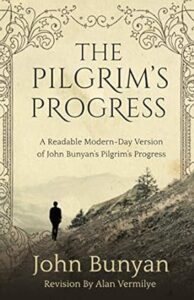Pilgrim’s Progress Timeless Tale
Many years ago, an acquaintance gave me a copy of Foxe’s Book of Martyrs, a history of the persecution of Protestants that dates back to 1563. The fact that a book published more than 460 years ago remains in print is testimony to its impact.
However, just a few pages into the first chapter, I stopped, set it aside, and have lost track of the bookshelf where it now resides. The reason: its antiquated verbiage. After a succession of “ye’s,” “thee’s” and “thou’s,” I gave up.
Fortunately, when it came to another Christian classic, John Bunyan’s Pilgrim’s Progress, my first exposure came via an updated edition.
The leader of the home Bible study group we attend recently proposed we tackle the book, along with a study guide that delves further into the deeper meanings of the popular allegory.
Pilgrim’s Progress: Long-Lasting Title

Yet until we delved into the study guide, I had no idea of the popularity of Bunyan’s writing, which ranks second to only the Bible in sales. Nor of the author’s background: he was the poor son of a metalworker who traveled about mending pots and pans.
While he rarely went to church growing up, after coming to Christ through the influence of his first wife, Bunyan became so serious about his faith that he became a lay preacher at the age of 25.
Bunyan endured tragedy and hardship during the years that followed, including the death of his wife and later imprisonment for 12 years. The latter came after King Charles II ordered all preachers outside of the Church of England banished or imprisoned.
Simple Story
The fact that this self-styled preacher had no formal education yet wrote a book that is popular nearly 350 years after publication is a reminder of Acts 4:13: “Now when (the Pharisees) saw the boldness of Peter and John, and perceived that they were uneducated, common men, they were astonished” (MEV, emphasis added).
I think one reason for the enduring appeal of Bunyan’s story is its simplicity. Sometimes the characters’ names seem so obvious they take on a comic tinge. Names like Christian, Worldly Wiseman, Obstinate, Pliable, Mr. Legality, or Arrogant.
Yet, like all good allegories, Bunyan’s tale (related in the form of a dream that unfolds in colorful detail) expresses larger ideas in an approachable style.
Many are likely familiar with the essence of the story: the lead character, Christian, sets out on a journey to the Celestial City, which he read about in a book that clearly symbolizes the Bible.
Enduring Obstacles

Worldly Wiseman also seeks to detour Christian, telling him he can find an easier way by visiting the Village of Morality and seeking advice from Mr. Legality. Wiseman advises if Legality’s not home to talk to his son, Civility.
And so it goes, with a succession of human foes trying to dissuade Christian from reaching the Celestial City, whether through worldly wisdom or mischaracterizations of why he should seek to reach heaven.
Bunyan’s ageless story cleverly illustrates the timeless battle between good and evil, with evil always trying to exert its influence. It happens today, just like it did in Bunyan’s time.


